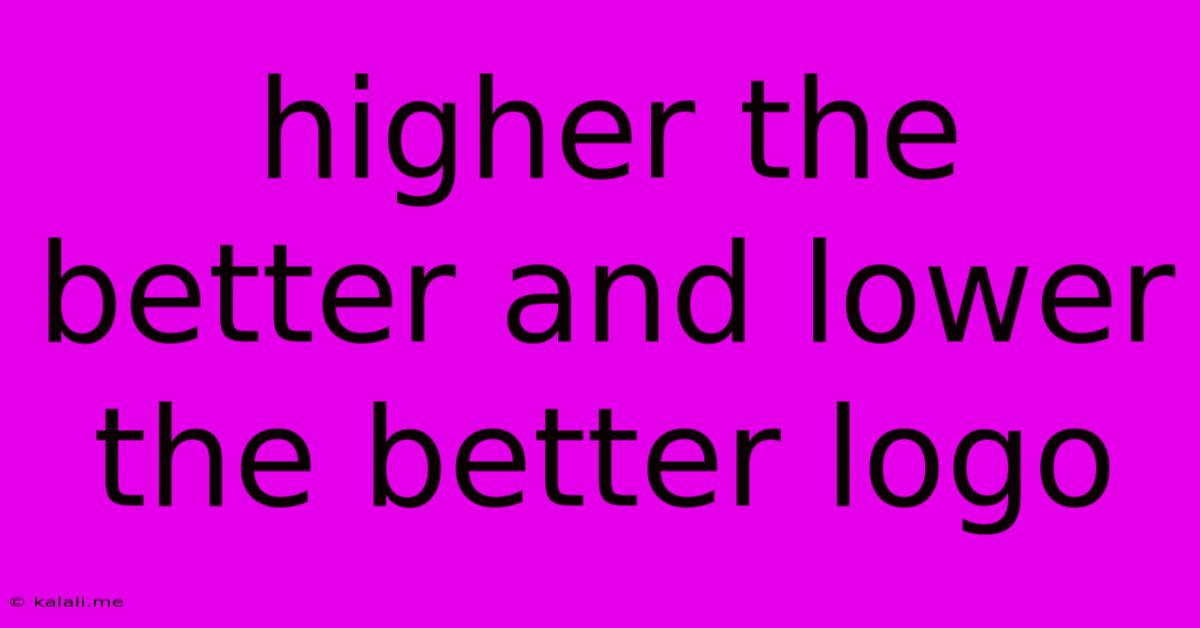Higher The Better And Lower The Better Logo
Kalali
Jun 01, 2025 · 3 min read

Table of Contents
Higher the Better & Lower the Better Logos: Understanding the Design Principles
Designing a memorable and effective logo requires understanding various design principles. One often overlooked, yet crucial aspect, is the concept of "higher the better" and "lower the better" logos. This refers to the placement of elements within the logo and how this placement influences its perception and readability. This article delves into these design principles, providing examples and guidance for creating impactful visual branding. This will help you understand how to choose the optimal approach for your specific brand and target audience.
What is a "Higher the Better" Logo?
A "higher the better" logo places the most important or visually dominant element at the top of the design. This creates a sense of hierarchy and importance, guiding the viewer's eye naturally upward. This approach is often employed when communicating concepts related to leadership, prestige, growth, or aspiration.
-
Examples: Think of logos featuring a soaring bird, a mountain peak, or an upward-pointing arrow. These elements visually represent upward movement and ambition, successfully conveying a "higher the better" message.
-
When to Use: This design strategy is ideal for brands aiming to convey superiority, ambition, innovation, or a sense of advancement. Companies in industries like technology, finance, and aviation often benefit from this approach.
-
Considerations: Ensure the top element is clearly the focal point and doesn't overshadow other essential components. Maintain a balanced composition to avoid a top-heavy feel.
What is a "Lower the Better" Logo?
Conversely, a "lower the better" logo emphasizes elements positioned lower in the design. This approach often suggests stability, groundedness, or connection to the earth. It can be particularly effective for brands focused on security, reliability, or tradition.
-
Examples: Logos featuring solid foundations, rooted plants, or a stable base often employ this principle. The visual weight is centered at the bottom, instilling a sense of security and permanence.
-
When to Use: This is suitable for brands seeking to project trustworthiness, dependability, or a connection to nature. Companies in industries such as agriculture, construction, and real estate often find this design effective.
-
Considerations: Avoid making the logo feel too bottom-heavy, potentially causing visual instability. A well-balanced composition is crucial, even when prioritizing lower placement.
Choosing the Right Approach: Factors to Consider
The choice between a "higher the better" and "lower the better" logo depends largely on your brand's identity and messaging. Consider these factors:
- Brand Values: What are the core values you want to communicate? Ambition and growth? Stability and trust?
- Target Audience: Who are you trying to reach? Their perception of "up" and "down" can influence the effectiveness of your logo design.
- Industry: Certain industries naturally lend themselves to one approach over the other.
- Logo Elements: The visual elements themselves – their inherent symbolism and inherent weight – play a critical role in the overall impact.
Beyond Simple Vertical Placement:
It's essential to note that "higher the better" and "lower the better" are not rigid rules. The placement is often relative within the logo itself. The principles can be applied subtly and creatively, even incorporating elements that defy a strict vertical hierarchy. Consider visual weight and the overall composition. A skilled designer can use these principles as a guide, not a limitation, to create a logo that truly reflects your brand's essence.
Conclusion:
Understanding the concepts of "higher the better" and "lower the better" logos is vital for creating a visually impactful and strategically sound brand identity. By carefully considering your brand values, target audience, and industry, you can make informed decisions about logo design that resonates deeply with your viewers and effectively communicates your brand message. Remember, the best logo is one that is both aesthetically pleasing and strategically aligned with your brand's goals.
Latest Posts
Latest Posts
-
Laminate Wood Vs Engineered Wood Flooring
Jun 03, 2025
-
What Is A Reference From An Ex Coworker
Jun 03, 2025
-
Where To Run Ac Condensate Drain Line
Jun 03, 2025
-
Dwarf Fortress Mod For Stone Pickaxe
Jun 03, 2025
-
4 Way Switch Wiring Diagram Pdf
Jun 03, 2025
Related Post
Thank you for visiting our website which covers about Higher The Better And Lower The Better Logo . We hope the information provided has been useful to you. Feel free to contact us if you have any questions or need further assistance. See you next time and don't miss to bookmark.